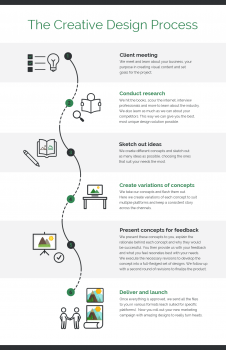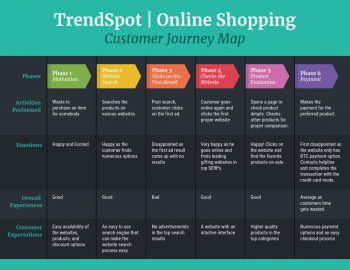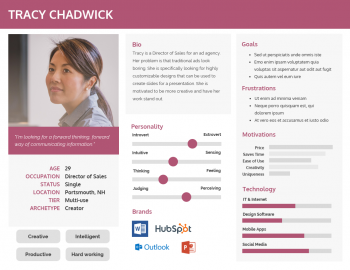Business processes can make or break the customer-brand relationship. But a number of companies struggle to identify issues early enough to secure this relationship.
We share 10 ways business processes can be improved for a more customer-centric approach.
Identify the Business Position

If your teams do not understand your business, they can’t help your customers. What is your company’s mission? How are you planning to get there?
And it isn’t just what you want to do with your business that matters—the ‘why’ is equally important.
Why is your company modeled in the way that it is? Why have you chosen to target this customer segment?
There are even further considerations to take into account. Such as, what are your company’s objectives—not only in the long-term but for each individual project.
A business infographic can outline the mission and vision of your company, for employees and customers.
You also need to look at what has and hasn’t worked in the past—an analysis of customer strategies that were successful is in order.
But you have to look at the missteps of the past, as well. This will help you understand what technologies, gaps, and processes are still required to improve customer experience.
Brand Building
When businesses think of branding, they often fail to see beyond the physical elements—the logo, the colors, and the fonts.
But there is so much more to branding than this—brand tone and community are as important, if not more.
While physical branding elements ensure recognition, they aren’t enough to secure customer retention.
The tone of voice companies use in their communications—on social media, websites, email marketing, live chat, and during customer service calls—makes a lasting impression.
There should be consistency in the tone used—for better recognition, as well as for the comfort of customers.
Community building should also be considered a part of branding—creating a ‘brand family’ is important, especially in the brand-saturated environment we live in now.
If you want to appeal to your customers, you need to think of your brand not as a physical, external entity, but as a member of the community standing alongside customers.
Customer Journeys

The customer’s journey in relation to your business and product has a major impact on how they perceive you and engage with your company.
If your business processes do not account for where the customer is in their journey, you could lose them entirely.
When your customer is in the motivation phase—where they are in need of an item but are unsure whom to buy it from—you need to highlight how your product can better their life.
To stand out from the crowd of competitors, you also need to share the extras that your product offers—after-sale services, longer warranties, and additional assistance.
Map out your customer journeys in an infographic that your employees and customer service teams can refer to whenever the need arises.
Buyer Personas

Who are your ideal customers? If you don’t have an answer for this, you can’t update your business processes to align with their needs.
This is why building buyer personas is an essential part of customer service.
Businesses can create survey questions to learn more about their customers’ needs and prioritize their processes accordingly.
Some of the questions that can be included in the survey include the following:
-
How did you learn about this product?
What are your immediate needs from the product?
Have you purchased from us before/ visited our website before?
How would you rate your experience with the product/ website/ checkout?
What other support can we provide for you?
Understanding customers’ pain points will help you define what changes you need to make within your processes to serve them better.
Standardizing Information
Customer services need to be standardized—to a point. It shouldn’t be so rigid that service agents have no room for creativity for unexpected issues.
It is important that the information agents have and share with clientele shouldn’t contradict—because customers will engage with numerous agents over time.
Steps should also be taken to avoid information bottlenecks or overloads—you don’t want employees to constantly put customers on hold for solutions.
Nor does anyone want a customer to be bombarded with product recommendations, services, and sundry facts when they want a single problem solved.
Companies should endeavor to standardize not only the kind of information shared with employees but also the process required to engage with clients to ensure uniformity.
Creating a knowledge base that is accessible to customer service employees and that is regularly updated with new learnings should be a priority.
This will also ensure risk management plans are effective in case of customer emergencies.
Customer Touchpoints
There are a number of customer touchpoints that are overlooked in business processes—this leads to poor customer experiences.
Companies need to anticipate possible issues and address them before customers are impacted.
For instance, during a high sales season, sales personnel keep stock of how quickly items are being sold. If they are given a threshold, they know when they need to call for more supplies.
This way, customers continue to receive their product without having to wait or make a complaint.
Companies can use a timeline infographic to outline the customer touchpoints and the actions that should be undertaken.
Automated Tasks
One way to speed up business processes and to boost customer satisfaction is to automate certain tasks.
Chatbots can be used to immediately respond to customers who have simpler queries—for more complex issues, a customer service agent can be brought in.
Automation can also help to retain customers—emails generated at the cart abandonment stage can remind reluctant prospects to return for a purchase.
By using automated tools, companies can also gain insights into their customers, response times, and how effective their strategy has been.
Examine Your UX

Is the user experience of your website, apps, and social media comforting and encouraging for customers?
If you weren’t part of this company, would you know how to navigate to your destination?
The UX of your brand must be geared towards customer experience. To ensure customers are comfortable with your brand’s channels, you need to optimize the processes entailed.
For instance, your website should make it easy for customers to click-through to purchase—too many pages in between could send them away from your site before the payment goes through.
While advertising is necessary, too many popups and visuals around the actual content of your site could act as a deterrent to customers.
Prioritize CX
At the end of the day, ensuring a smooth experience for customers across all channels is what you need to increase sales.
To do so, companies need to be proactive—in learning what barriers could stand in the way of customers and eliminating them.
Understanding customers—not just their needs or product desires, but what motivates them to engage with a brand or purchase an item—goes a long way in improving experiences.
And always be willing to learn and improve how you do business and handle customers.
Measure Your Results
The best way to keep improving is to measure and analyze projects and results. This can be a difficult process—and harder to be objective—but the learnings are necessary for growth.
Instead of having a hypothetical understanding of business processes, do a complete walkthrough—put yourself in the customer’s shoes so you don’t miss anything.
If changes are required, make them—the time and energy it takes to deal with complaints will far outweigh how much is spent on making a few quick changes.
Be open to feedback—if people are having trouble with one step in the process, it can’t be a problem with them.
Learn from the wins and the failures, and you will be able to deliver a more positive customer experience.
Conclusion: Put Customers First
Without customers, businesses cannot run—which is why making the process for them to find you and purchase from you is so important.
Use the above ten points to improve your business processes so your customers have a strong reason to return to you.



